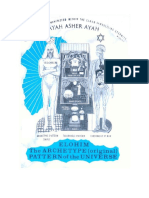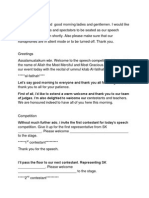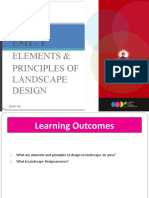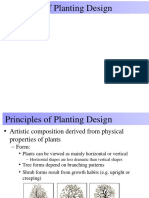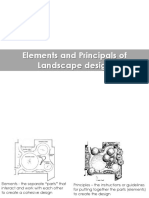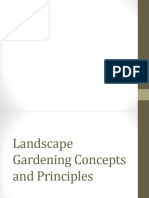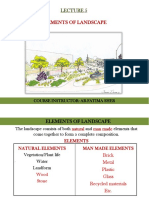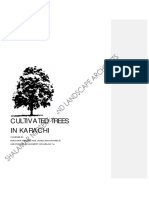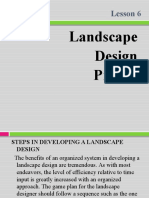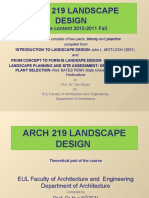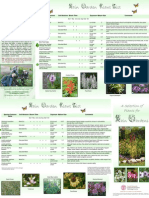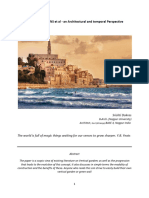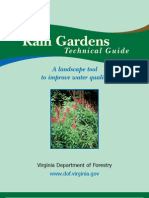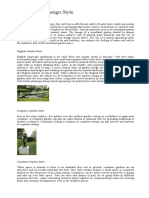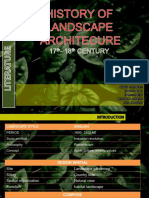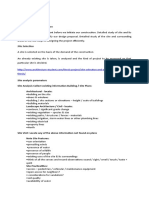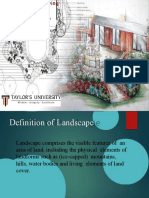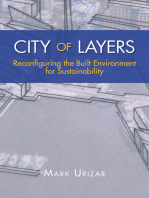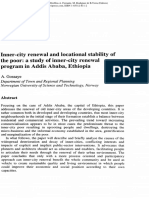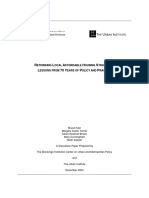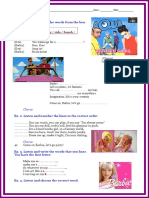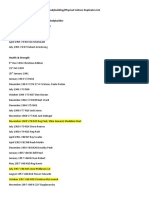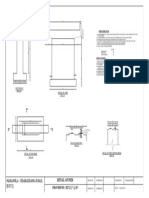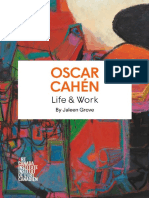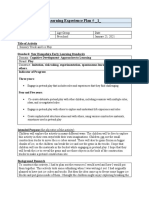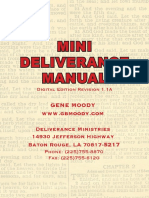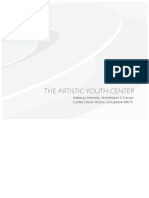0 ratings0% found this document useful (0 votes)
92 viewsLandscape Design Presentation
Landscape Design Presentation
Uploaded by
Dawod AbdieThis document discusses key elements of landscape design including line, form, texture, color and visual weight. It explains how landscape designers use these elements and principles of design to create aesthetically pleasing and functional outdoor spaces. Elements such as line, form, texture and color are used purposefully to enhance the visual experience and guide the user's eye through the landscape. The principles of proportion, order and repetition help organize these elements into a cohesive composition.
Copyright:
© All Rights Reserved
Available Formats
Download as PPT, PDF, TXT or read online from Scribd
Landscape Design Presentation
Landscape Design Presentation
Uploaded by
Dawod Abdie0 ratings0% found this document useful (0 votes)
92 views43 pagesThis document discusses key elements of landscape design including line, form, texture, color and visual weight. It explains how landscape designers use these elements and principles of design to create aesthetically pleasing and functional outdoor spaces. Elements such as line, form, texture and color are used purposefully to enhance the visual experience and guide the user's eye through the landscape. The principles of proportion, order and repetition help organize these elements into a cohesive composition.
Original Title
landscape design presentation
Copyright
© © All Rights Reserved
Available Formats
PPT, PDF, TXT or read online from Scribd
Share this document
Did you find this document useful?
Is this content inappropriate?
This document discusses key elements of landscape design including line, form, texture, color and visual weight. It explains how landscape designers use these elements and principles of design to create aesthetically pleasing and functional outdoor spaces. Elements such as line, form, texture and color are used purposefully to enhance the visual experience and guide the user's eye through the landscape. The principles of proportion, order and repetition help organize these elements into a cohesive composition.
Copyright:
© All Rights Reserved
Available Formats
Download as PPT, PDF, TXT or read online from Scribd
Download as ppt, pdf, or txt
0 ratings0% found this document useful (0 votes)
92 views43 pagesLandscape Design Presentation
Landscape Design Presentation
Uploaded by
Dawod AbdieThis document discusses key elements of landscape design including line, form, texture, color and visual weight. It explains how landscape designers use these elements and principles of design to create aesthetically pleasing and functional outdoor spaces. Elements such as line, form, texture and color are used purposefully to enhance the visual experience and guide the user's eye through the landscape. The principles of proportion, order and repetition help organize these elements into a cohesive composition.
Copyright:
© All Rights Reserved
Available Formats
Download as PPT, PDF, TXT or read online from Scribd
Download as ppt, pdf, or txt
You are on page 1of 43
At a glance
Powered by AI
The key takeaways are that landscape design uses elements and principles of design to create functional and aesthetically pleasing outdoor spaces.
The elements of design are line, form, texture, color, and visual weight.
The principles that guide landscape design are proportion, order, repetition, and unity.
PLANTS AND PLANTING DESIGN
landscape design that is distinctly different from
other art forms
•The “art” is always changing as the plants grow,
environmental conditions change, and people use
the space.
•landscape designers use a design process that
systematically considers all aspects of the land, the
environment, the growing plants, and the needs of
the user
To ensure a visually pleasing,
Functional, and
Ecologically healthy design.
• Elements and Principles
• Design process begins by
Determining the needs and desires of the user
and
The conditions of the site
then organizes the plants and hardscape materials
Using the visual qualities of
line,
form,
color,
texture,
visual weight—the elements of design
• The principles are the fundamental concepts of
composition—like
proportion,
order,
repetition,
unity
that serve as guidelines to arrange or organize the
elements and to create an aesthetically pleasing
or beautiful landscape.
• Elements of composition are the visual qualities
that people see and respond to when viewing a
space
Line
• Line in the landscape is created by the edge between
two materials, the outline or silhouette of a form, or a
long linear feature
• Landscape designers use lines to create
patterns, develop spaces, create forms, control
movement, establish dominance, and create a
cohesive theme in a landscape
• Line can also be created by long and narrow
materials, such as a fence or wall
Landscape lines are created several ways: when the edge
of an object is visible or contrasts with a background,
such as the outline of a tree against the sky; or by the
placement of a material in a line, such as a fence
Properties of Lines
•The properties of lines determine how people respond
to the landscape, both emotionally and physically.
Straight lines
•structural and forceful;
•create a formal character, are usually associated with
a symmetrical design, and lead the eye directly to a
focal point.
•Diagonal lines are straight lines with an intentional
direction.
•Straight lines are most often found in hardscape edges
and material.
Curved lines
• Curved lines create an informal, natural,
relaxed character
• associated more with nature and
asymmetrical balance
• lines move the eye at a slower pace and add
mystery to the space by creating hidden views.
Vertical lines
• Vertical lines move the eye up, making a
space feel larger.
• An upward line can emphasize a feature and
has a feeling of activity or movement.
Vertical lines in the landscape include tall,
narrow plant material, such as trees,
• Horizontal lines
• Horizontal lines move the eye along the ground
plane and
• can make a space feel larger. Low lines are more
subdued and create a feeling of rest or repose.
• Horizontal lines can spatially divide a space or tie
a space together.
• Low lines are created by low garden walls,
walkways, and short hedges.
Form
•Shape is created by an outline that encloses a space, and
form is the three-dimensional mass of that shape.
• Form is found in both hardscape and plants, and it is
typically the dominant visual element that spatially
organizes the landscape and often determines the style of
the garden.
• Formal, geometric forms include circles, squares, and
polygons.
Plant Forms
•Form is the most enduring quality of a plant
•Form is the most consistent and recognizable
characteristic of plants
•the massing of plants, where the overall mass
creates a different form than an individual plant
•A strong form that contrasts with the rest of
the composition will have greater emphasis
within the composition
• A highly contrasting form must be used with care
—one or two work well as a focal point, but too
many create chaos
• Natural plant forms, rather than over-trimmed
forms, should establish the bulk of the
composition
Tree forms
•Common tree forms include round,
columnar, oval, pyramidal, vase and
weeping.
• Different tree forms are used for visual
appeal, but the form is also important for
function.
•Creating a shady area in the garden
requires a round or oval tree,
•while a screen usually requires a more
columnar or pyramidal form, and a
•weeping tree form makes a good focal
point.
• Shrub forms
• Shrub forms include upright, vase shaped, arching, mounding,
rounded, spiky, cascading, and irregular.
• Choosing shrub forms often depends on whether the shrub will be
used in a mass or as a single specimen.
• Mounding and spreading shrubs look best in a mass, and
• cascading and vase-shaped shrubs do well as specimen plants.
• Groundcover forms
• Groundcover forms include matting,
spreading, clumping, sprawling, and
short spikes.
• Almost all groundcovers look better in
masses because they are typically small,
ground-hugging plants that have very
littleimpact as individual plants.
Properties of Form
•Repetition of form is essential to the creation of pattern,
which is the basic organizational structure of the
landscape.
•Form compatibility is also a major component of unity
in design
•one or two strikingly different forms are good for
contrast and emphasis,
•but generally all other forms should have some
similarities for a unified look.
Texture
• Texture refers to how coarse/rough or fine/smooth the
surface of the plant or hardscape material feels and/or looks.
• Texture is used to provide variety, interest, and contrast
• Coarse texture is more dominant than fine and also tends to
dominate color and form
• Coarse texture is more dominant than fine and also tends to
dominate color and form
• while fine texture is more subordinate to other qualities and
tends to unify compositions
• Fine texture exaggerates distance and gives the feeling of a
larger, more open space
• Rough texture minimizes distance—plants appear closer
Coarse texture Fine texture
large leaves; leaves with very Small foliage; thin,
strappy leaves (grasses)
irregular edges; bold; or tall, thin stems;
variegated colors; thick and small branches;
branches; leaves and long stems (vines); and
small, delicate flowers
Medium texture
Most plants are medium
texture,
medium-sized leaves
with simple shapes
and smooth edges
Properties of Texture
•Texture affects the perception of distance and
scale. To make a space feel larger, locate plants so
that the fine textures are along the outer perimeter,
the medium textures are in the middle, and the
coarse textures are closest to the viewer.
•The small size of the fine texture recedes in the
Landscape and is perceived as being farther away.
Color
• Color in plant material and hardscape adds interest and
variety to the landscape.
• The most temporary element
clour schemes
• Monochromatic scheme
• A monochromatic color scheme uses only one color. A
garden that is all green depends more on form and texture
for contrast and interest.
• One color can have many light and dark variations,
which can add interest.
• An example of a monochromatic scheme is a white
garden with white flowers, white variegated foliage, and
white garden ornaments.
Analogous scheme
•Analogous (sometimes called harmonious) color
schemes are any three to five colors that are
adjacent on the color
wheel, such as red, red-orange, orange, yellow-
orange, and yellow, or blue, blue-violet, and violet.
•The colors are related to each other because they
typically include two primary colors mixed to form
a secondary and two tertiary colors, which means
they share common properties.
Complementary scheme
• Complementary colors are those that are opposite each
other on the color wheel. They tend to have high
contrast between them. The most common sets are
violet and yellow,
• red and green, and blue and orange. Complementary
colors are often found aturally in flowers; a common
pair is yellow and violet.
• Color is found in the flowers, foliage, bark,
and fruit of plants. Foliage typically provides
the overall background
• Green foliage in all its various shades is the
dominant color by quantity, but other colors
capture attention more readily because of their
high contrast to the color green.
• Color is also found in buildings, rocks, pavers,
wood, and furniture. Most colors in natural
materials, such as stone and wood, are typically
muted and tend to be variations of brown, tan, and
pale yellow.
• Bright colors in the hardscape are usually found in
man-made materials, such as painted furniture,
brightly colored ceramic containers or sculptures,
and glass ornaments.
Properties of Color
•Color is an important element for creating interest
and variety in the landscape. Colors have properties
that can affect emotions, spatial perception, light
quality, balance, and emphasis.
•Warm colors tend to be more exciting and should
be used in areas for entertaining and parties.
•Cool colors tend to be calming and should be used
in areas for relaxation and serenity.
• Focal points can be created with bright colors
• bright yellow, which has the highest intensity,
also has a high contrast with all other colors
Visual Weight
• Visual weight is the concept that combinations of
certain features have more importance in the
composition based on mass and contrast.
• Some areas of a composition are more noticeable and
memorable, while others fade into the background.
• A composition where all features have high visual
weight often looks chaotic
• High visual weight usually comes from a group of
plants with characteristics of
Upright or unusual forms
large size
Warm Colors,
Bold texture,
Diagonal lines.
• Low visual weight is found in
Visual weight by mass and
Low horizontal lines, contrast
prostrate or low forms,
Fine texture, and
Subdued or dull colors
Principles of Design
Design principles guide designers in organizing elements
for a visually pleasing landscape.
• A harmonious composition can be achieved through
the principles of proportion, order, repetition, and
unity and the like
Proportion
•Relative proportion is the size of an object in relation to
other objects.
• Absolute proportion is the scale or size of an object. An
important absolute scale in design is the human scale
(size of the human body) because the size of other
objects is considered relative to humans.
• Plant material, garden structures, and ornaments
should be considered relative to human scale. Other
important relative proportions include the size of the
house, yard, and the area to be planted.
Proportion in plants
•Proportion can be found in plant material relative to people
the surrounding plants, and the house. When all three are in
proportion, the composition feels balanced and harmonious.
• A feeling of balance can also be achieved by having equal
proportions of open space and planted space.
•Using markedly different plant sizes can help to achieve
dominance (emphasis) through contrast with a large plant.
•Using plants that are similar in size can help to achieve
rhythm through repetition of size.
Proportion in plants and hardscape
•A feeling of balance can also
be achieved by having equal
proportions of open space and
planted space.
•Using markedly different plant
sizes can help to achieve
dominance (emphasis) through
contrast with a large plant
•Using plants that are similar in
size can help to achieve rhythm
through repetition of size.
ORDER
• Order generally refers to the spatial layout or
organization of the design and is most often
achieved through balance
• Balance is the concept of equal visual attraction
and weight, usually around a real or imaginary
central axis
• Form, color, size, and texture all affect balance
• Balance can be symmetrical, asymmetrical.
• Order can also be achieved by massing
features or elements into distinct groups and
arranging them around a central point
Symmetrical balance
• Symmetrical balance is achieved when the
same objects (mirror images) are placed on
either side of an axis.
Asymmetrical balance
• Asymmetrical balance is achieved by equal visual
weight of nonequivalent forms, color, or texture on
either side of an axis
To create balance, features
with large sizes, dense forms,
bright colors, and coarse
textures appear heavier and
should be used sparingly,
while small sizes, sparse
forms, gray or subdued colors,
and fine texture
appear lighter and should be
used in greater amounts
Repetition
• Repetition is created by the repeated use of
elements or features to create patterns or a
sequence in the landscape
• Repeating line, form, color, and texture creates
rhythm in the landscape
• Repetition must be used with care—too much
repetition can create monotony, and too little can
create confusion
Repetition in plants and hardscape
• A grass garden is a good example of subtle plant
repetition
• Gradation can be achieved with a gradual change in
height or size (e.g., using small grasses in front, backed
by medium grasses, and then large grasses)
• Material can be used repeatedly throughout the yard
for unity, but interest can be created by slightly varying
the size, texture, or color of hardscape material
Unity
• Unity is achieved by linking elements and features to create a
consistent character in the composition
• Unity is sometimes referred to as harmony—the concept of
everything fitting together
• Unity is achieved by using dominance, interconnection,
• Although hardscapes and plants can be unified by the blending
of similar characteristics, some variety is also important to
create interest
• The simplest way to create unity is through the use of a design
theme or a design style
Unity by dominance
• Dominance or emphasis is the property of a plant or
object that attracts and holds attention, making the
object an important feature
• The ability of an object to capture attention usually
depends on contrast with adjacent objects
Typical example for a garden would be a very brightly
colored ceramic pot among green foliage
• Dominant features that capture attention are called
focal points
• Plants that draw attention are often called specimen
plants. These are plants with a unique form, size, or
texture that stand out from the surrounding plants
• Specimen plants are usually used to draw attention
to entrances, pathways, or statuary
• Form and color are usually the characteristics that
contrast the most hardscpe with plants
Unity by interconnection
•Interconnection, the concept of physical linkage
of various elements,
• Although all features are linked to other
elements, the key is to make the linkage so that
the features blend or fit together.
• Continuation of a line, such as a path, the edge
of a built object, or a defined edge of a plant bed,
can create unity through interconnection.
Unity by simplicity
• Simplicity is the concept of reducing or
eliminating nonessentials to avoid a chaotic
look
• Many designers achieve simplicity by
thoughtfully removing features from a design
while still preserving its integrity
Summary
• The fundamental concept of landscape design is problem
solving through the use of horticultural science, artful
composition, and spatial organization to create attractive
and functional outdoor environment for different uses.
• The elements (visual qualities)—line, form, texture, color,
and visual weight, and principles (guidelines) —
proportion, order, repetition, and unity of design are used
to create spaces, connect them, and make them visually
pleasing to the eye.
You might also like
- About The MpungosDocument4 pagesAbout The MpungosTata Sarabanda100% (7)
- IDMR TextDocument337 pagesIDMR TextAndrew LoboNo ratings yet
- Broadleaf Trees Student SheetDocument1 pageBroadleaf Trees Student SheetNit EshNo ratings yet
- Emcee ScriptDocument2 pagesEmcee Scriptzairulhishamipgkdri0% (1)
- Bar Graph Abstract Painting V 1Document15 pagesBar Graph Abstract Painting V 1teddbNo ratings yet
- Principles of Landscape DesignDocument17 pagesPrinciples of Landscape DesignAreeba Parvez100% (1)
- Landscape ArchitectureDocument10 pagesLandscape ArchitecturebobbyNo ratings yet
- Unit - I: Elements & Principles of Landscape DesignDocument28 pagesUnit - I: Elements & Principles of Landscape DesignSahar ZehraNo ratings yet
- Concepts of Landscape DesignDocument36 pagesConcepts of Landscape DesignPhuong Thi Le100% (2)
- Principles of Planting DesignDocument21 pagesPrinciples of Planting DesignLawrence ConananNo ratings yet
- Principles of Landscape DesignDocument6 pagesPrinciples of Landscape DesignUbaid KhanNo ratings yet
- Elements and Principals of Landscape DesignDocument35 pagesElements and Principals of Landscape DesignSurabhi Mendhe100% (1)
- Concepts of Landscape DesignDocument36 pagesConcepts of Landscape DesignNikilsha KNo ratings yet
- Concepts of Landscape DesignDocument67 pagesConcepts of Landscape DesignSharmaine Carrera100% (2)
- Landscape Design PrinciplesDocument12 pagesLandscape Design PrinciplesanuthilakNo ratings yet
- Landscape Architecture and Environmental DesignDocument165 pagesLandscape Architecture and Environmental DesignAnkit GuptaNo ratings yet
- Landscaping PDFDocument45 pagesLandscaping PDFDianaMocodeanNo ratings yet
- Landscape DesignDocument37 pagesLandscape DesignScott Andrew Serrano100% (1)
- Elements of Design: 1. LineDocument9 pagesElements of Design: 1. LineKeannosuke SabusapNo ratings yet
- Landscape Design (4. Elements in Landscape Design)Document7 pagesLandscape Design (4. Elements in Landscape Design)Hafsah SiddiquaNo ratings yet
- Landscape Architecture Lecture 5Document36 pagesLandscape Architecture Lecture 5Ali WAHEEDNo ratings yet
- Climate and VegetationDocument82 pagesClimate and VegetationsereneNo ratings yet
- Street Tree Design Guidelines 50b9 2965Document48 pagesStreet Tree Design Guidelines 50b9 2965Kranthi Kumar Chowdary ManamNo ratings yet
- Trees in KarachiDocument176 pagesTrees in KarachiOmer Yousuf0% (1)
- Landscape Design Process: Lesson 6Document37 pagesLandscape Design Process: Lesson 6vandy nehalia100% (1)
- Arch 219 Landscape Design1Document160 pagesArch 219 Landscape Design1enesakman100% (2)
- South Dakota Living Landscapes: A Guide To Native PlantScapingDocument45 pagesSouth Dakota Living Landscapes: A Guide To Native PlantScapingFree Rain Garden Manuals100% (1)
- Landscape DesignDocument4 pagesLandscape DesignzoliNo ratings yet
- Steps in Developing A Landscape DesignDocument12 pagesSteps in Developing A Landscape DesignAesha Upadhyay100% (1)
- Consumer Preference Towards Cafes in Coimbatore: Under The Supervision of Chandra MamDocument16 pagesConsumer Preference Towards Cafes in Coimbatore: Under The Supervision of Chandra MamSanjay PrakashNo ratings yet
- The Landscape Planning Techniques For Large Scale ProjectsDocument39 pagesThe Landscape Planning Techniques For Large Scale ProjectsKhushboo KhanNo ratings yet
- Evolution of Garden Design: M.Arch Landscape Assistant Professor GITAM School of Architecture Hyderabad Prepared byDocument23 pagesEvolution of Garden Design: M.Arch Landscape Assistant Professor GITAM School of Architecture Hyderabad Prepared bynihaNo ratings yet
- New York Rain Garden Plant List - Cornell UniversityDocument2 pagesNew York Rain Garden Plant List - Cornell UniversityFree Rain Garden Manuals and MoreNo ratings yet
- Landscape Principles.......Document6 pagesLandscape Principles.......Nupur BhadraNo ratings yet
- Randolph m4Document5 pagesRandolph m4api-344446892No ratings yet
- VERTICAL GARDEN - Srishti Dokras PDFDocument15 pagesVERTICAL GARDEN - Srishti Dokras PDFKIINSXX Music100% (1)
- Needle Grasses and Weeping Trees Student SheetDocument1 pageNeedle Grasses and Weeping Trees Student SheetNit EshNo ratings yet
- Elementsoflandscapedesign 140504071921 Phpapp02 PDFDocument19 pagesElementsoflandscapedesign 140504071921 Phpapp02 PDFSilvy BhatiaNo ratings yet
- Landscape City and People PDFDocument136 pagesLandscape City and People PDFMisha Jose100% (1)
- Landscape Planning Eid. Tom TurnerDocument494 pagesLandscape Planning Eid. Tom TurnerRaluca100% (1)
- Virginia Rain Gardens Technical GuideDocument36 pagesVirginia Rain Gardens Technical GuideFree Rain Garden Manuals and More100% (2)
- Renewable and Sustainable Energy Reviews: A.R. Dehghani-Sanij, M. Soltani, K. RaahemifarDocument14 pagesRenewable and Sustainable Energy Reviews: A.R. Dehghani-Sanij, M. Soltani, K. RaahemifarNaynaNo ratings yet
- Principles of LandscapingDocument29 pagesPrinciples of LandscapinglakshitaNo ratings yet
- Landscape Design StyleDocument12 pagesLandscape Design StyleAde KurniawanNo ratings yet
- Landscape M StudyDocument53 pagesLandscape M StudypalaniNo ratings yet
- Landscape Architecture FinalDocument14 pagesLandscape Architecture Finalluxinxuan100% (1)
- Green Sustainable Parking GuideDocument62 pagesGreen Sustainable Parking GuideXtian AnesNo ratings yet
- Kuliah 1 Landscape ArchitectureDocument12 pagesKuliah 1 Landscape ArchitectureAmy RahimNo ratings yet
- Elements of LandscapingDocument18 pagesElements of Landscapingcyra elizaldeNo ratings yet
- Presentation BoardDocument4 pagesPresentation BoardGracelle Anne Pajarillaga PadolinaNo ratings yet
- Cty of Galesburg's Parks and Recreation Master PlanDocument77 pagesCty of Galesburg's Parks and Recreation Master Planregister-mailNo ratings yet
- Himalaya LandscapeDocument41 pagesHimalaya LandscapeHimalya HarryNo ratings yet
- History of Landscape GardensDocument14 pagesHistory of Landscape Gardensradhika goelNo ratings yet
- Fri-A7 Google SketchUp Presentation Graphics - Creating Effective Images and AnimationsDocument7 pagesFri-A7 Google SketchUp Presentation Graphics - Creating Effective Images and AnimationsKiran BasuNo ratings yet
- Advances Landscape Architecture I To 13Document935 pagesAdvances Landscape Architecture I To 13chinchay07100% (1)
- Landscape Arch. BasicsDocument24 pagesLandscape Arch. BasicsParz Rafael100% (1)
- Chandigarh's History and It's Urban Landscape Issues!Document46 pagesChandigarh's History and It's Urban Landscape Issues!Aswine RajanNo ratings yet
- Site Planning Ass 2Document5 pagesSite Planning Ass 2Angelika ComiaNo ratings yet
- LandscapDocument21 pagesLandscapAAMIR ALINo ratings yet
- Across the Open Field: Essays Drawn from English LandscapesFrom EverandAcross the Open Field: Essays Drawn from English LandscapesRating: 4 out of 5 stars4/5 (1)
- City of Layers: Reconfiguring the Built Environment for SustainabilityFrom EverandCity of Layers: Reconfiguring the Built Environment for SustainabilityNo ratings yet
- Urs 00044 FuDocument10 pagesUrs 00044 FuDawod AbdieNo ratings yet
- In Review: University of Michigan African Studies CenterDocument20 pagesIn Review: University of Michigan African Studies CenterDawod AbdieNo ratings yet
- LandTenureStudies09 1Document37 pagesLandTenureStudies09 1Dawod AbdieNo ratings yet
- Landscape Architecture: Plants and Planting DesignDocument33 pagesLandscape Architecture: Plants and Planting DesignDawod Abdie100% (1)
- Housing ReviewDocument138 pagesHousing ReviewDawod AbdieNo ratings yet
- Lecture 1 - The History of Landscape Design PDFDocument16 pagesLecture 1 - The History of Landscape Design PDFDawod AbdieNo ratings yet
- Affordability and Sustainability of Condominium Housing in Bahir DarDocument52 pagesAffordability and Sustainability of Condominium Housing in Bahir DarDawod AbdieNo ratings yet
- Applying: Design Fundamentals To Landscape DesignDocument21 pagesApplying: Design Fundamentals To Landscape DesignDawod AbdieNo ratings yet
- Concept DesignDocument72 pagesConcept DesignDawod Abdie100% (1)
- Cleaning and PackagingDocument17 pagesCleaning and PackagingDawod AbdieNo ratings yet
- Menu Tiga DariDocument22 pagesMenu Tiga DariAdityo Putra MahendraNo ratings yet
- Aqua Barbie Girl Activities With Music Songs Nursery Rhymes 42268Document3 pagesAqua Barbie Girl Activities With Music Songs Nursery Rhymes 42268Lidiane Oliveira BianchinNo ratings yet
- Bodybuilding Magazine Duplicates From Karl HineDocument6 pagesBodybuilding Magazine Duplicates From Karl HineGolden Era BookwormNo ratings yet
- MPMB's Ficha de Personagem Bonitinho PDFDocument7 pagesMPMB's Ficha de Personagem Bonitinho PDFNautilusNo ratings yet
- Marawila - Udabaddawa Road, (B272) Detail of PierDocument1 pageMarawila - Udabaddawa Road, (B272) Detail of PierJeyachandranAnuthasNo ratings yet
- Oscar Cahén: Life & WorkDocument111 pagesOscar Cahén: Life & WorkArt Canada Institute100% (3)
- June 2018Document7 pagesJune 2018AllanSalardaAdemNo ratings yet
- PadajucebrtveDocument11 pagesPadajucebrtveMonk3y MNo ratings yet
- Weirdest Christmas Traditions From Around The WorldDocument2 pagesWeirdest Christmas Traditions From Around The WorldMinhHuyen VuNo ratings yet
- BMMA DesignDocument74 pagesBMMA DesignChu UNo ratings yet
- Dramatic MonologueDocument1 pageDramatic MonologueRandomSingerGirlNo ratings yet
- LangstonHughesHarlem PDFDocument2 pagesLangstonHughesHarlem PDFUTSA ROYNo ratings yet
- Exercises I:: Subject Pronouns and Verb "To Be" Alumno: Michael Ybañez RevollarDocument3 pagesExercises I:: Subject Pronouns and Verb "To Be" Alumno: Michael Ybañez RevollarMichael YbañezNo ratings yet
- (Historical Dictionaries of Ancient Civilizations and Historical Eras volume 10) Richard A., Jr. Lobban - Historical Dictionary of Ancient and Medieval Nubia (Historical Dictionaries of Ancient Civili.pdfDocument585 pages(Historical Dictionaries of Ancient Civilizations and Historical Eras volume 10) Richard A., Jr. Lobban - Historical Dictionary of Ancient and Medieval Nubia (Historical Dictionaries of Ancient Civili.pdfAhmed Almukhtar100% (2)
- Narrative Report On Letter PressDocument13 pagesNarrative Report On Letter PressAmy Joy SamaritaNo ratings yet
- Dream TheaterDocument5 pagesDream TheaterMike SihombingNo ratings yet
- Learning Experience PlansDocument38 pagesLearning Experience Plansapi-545953505No ratings yet
- Mini Deliverance Manual Rev 1.1ADocument132 pagesMini Deliverance Manual Rev 1.1AGum Ja Naw100% (3)
- Film Appreciation AssignmentDocument12 pagesFilm Appreciation Assignmentking hopeNo ratings yet
- Isa Genzken: ParkettDocument8 pagesIsa Genzken: ParkettKatreni MaticceNo ratings yet
- The Bauhaus, 1919-1933 - Essay - Heilbrunn Timeline of Art History - The Metropolitan Museum of ArtDocument5 pagesThe Bauhaus, 1919-1933 - Essay - Heilbrunn Timeline of Art History - The Metropolitan Museum of ArtAmanda MonteiroNo ratings yet
- Ling-Cai - 2008 - Western Dragon and Chinese Long Mistranslation and ResolutionDocument5 pagesLing-Cai - 2008 - Western Dragon and Chinese Long Mistranslation and ResolutionzhousiruiNo ratings yet
- The Artistic Youth Center 2017 Camilla Thrane PDFDocument164 pagesThe Artistic Youth Center 2017 Camilla Thrane PDFZidane MuhammadNo ratings yet
- Week1 LectureDocument50 pagesWeek1 LectureSenaNo ratings yet
- Aldodonez Coanqui Adaluz: Give Leave Move Use WorkDocument3 pagesAldodonez Coanqui Adaluz: Give Leave Move Use WorkAdaLuzCoanquiNo ratings yet
- Drawing On Tradition. Translation, Martial Arts, and Japanese Anime in America - 189-210 - 29-06-2015Document22 pagesDrawing On Tradition. Translation, Martial Arts, and Japanese Anime in America - 189-210 - 29-06-2015Mirsailles16No ratings yet


